A crocodile is a reptile that lives in rivers and lakes in tropical and subtropical regions of Africa, Asia, and America. Children draw them because they are bright and memorable animals. They have a powerful tail and a massive body.
They are known for their ferocity and have powerful jaws that allow them to hunt large animals.
Necessary materials and tools
The listed materials and tools are basic for a beginner artist working with pencils. They allow you to create a variety of drawings, from simple sketches to complex compositions.
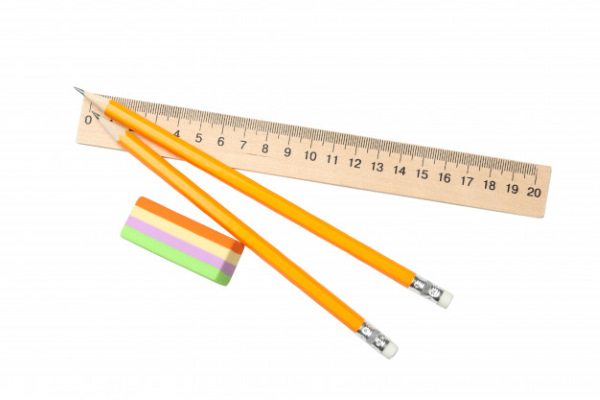
| Tools and materials | Brief description |
| Paper | It can be of different types and formats, for example, thick, intended for watercolors or pencil drawings, or special for graphic works. |
| Pencils | This is a tool used to apply strokes, lines and shadows. Pencils can have different hardness and softness, which allows the artist to choose the intensity of the stroke and create different effects on the paper. |
| Erasers and pens | Erasers come in a variety of shapes and sizes, and differ in their ability to erase. Kneaded erasers are a type of eraser that have a softer texture and allow you to gently correct your drawing without damaging the paper. |
| Stencils | These are tools that act as templates for creating repeating elements in a drawing. They can be made of various materials, such as plastic, metal or cardboard, and are used to quickly and accurately create identical elements. |
| Rulers, compasses | These are measuring instruments used to draw straight lines and circles. Rulers come in different lengths and graduations, while compasses are used to create perfect circles. |
| Sharpeners | This is a tool used to sharpen pencils. Sharpeners can be mechanical or manual, and the choice of sharpener depends on the artist's preferences and the type of pencil he or she uses. |
Master classes
Drawing a crocodile helps develop fine motor skills, attention and imagination.
To draw it, you need to take into account the following features:
- The crocodile's body should be elongated and slightly curved. It has an oval shape.
- The head should be large and round. Crocodiles have small eyes and a huge mouth.
- The tail is long and powerful. It should have a rounded shape.
- The crocodile lies on its stomach.
- Its paws are short and wide.
- The drawing can be done in different styles. Artists can use simple and colored pencils.
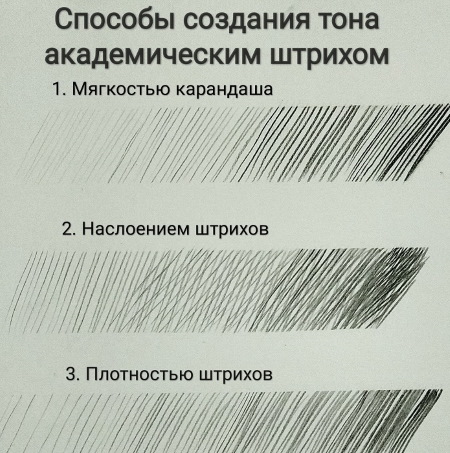
It is permissible to use various drawing techniques, such as hatching or shading.
In cartoon style
The crocodile in the picture is created using a step-by-step master class:
- Start by creating a general outline of the crocodile. Use simple shapes to create the base of the figure: an oval body, an oval or circle-shaped head, and a pointed arc-shaped tail. Mark the location of the eyes, nose, and mouth on the face.
Determine the proportions of the body: the head should be approximately ⅓ of the total body length, and the tail should take up the remaining part.
- Detail the muzzle using simple lines and shapes. The eyes can be round or slightly elongated, the nose a short triangle, the mouth a semicircle. You can add a smile or an evil grin.
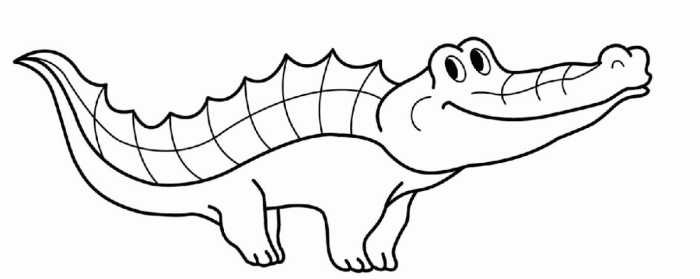
- Draw the body of a crocodile.
- The tail should be long and pointed at the end.
- The crocodile stands on 4 legs. Each of them consists of 3 fingers and has a rounded shape. For cartoon images, exaggeratedly long legs are used.
- Make the belly slightly bulge. This will add a fun element to the crocodile look.
- Draw all the details of the muzzle. Pay attention to the expressiveness of the eyes and nostrils, they should be clearly visible and emphasize the character's character.
- Draw the combs, make them simple and recognizable. They can serve as an additional decorative element and enhance the cartoon style. Draw small spikes on the tail.

- Use bright, saturated colors to color the drawing. Add contrasts and interesting combinations of shades.
Realistic
The crocodile in the picture is depicted by following the following steps:
- Draw the outline of the crocodile using a pencil. Start with simple lines to sketch the general layout of the head, body, and tail. Don't press hard on the pencil, as you can make changes later.
- Draw the shape of the crocodile's head, taking into account its characteristic features: wide jaws, small eyes and a pointed muzzle. Create the impression of volume using shadows and gradients.
- Add details to the crocodile's body. Note its elongated shape and oval cross-section. Outline the ribs and spine lines. To give volume and relief, add shadows to the belly and lighter areas to the back.
- Draw the crocodile's tail, giving it a triangular shape with a pointed tip. The tail should be long and thin, but at the same time have some volume.
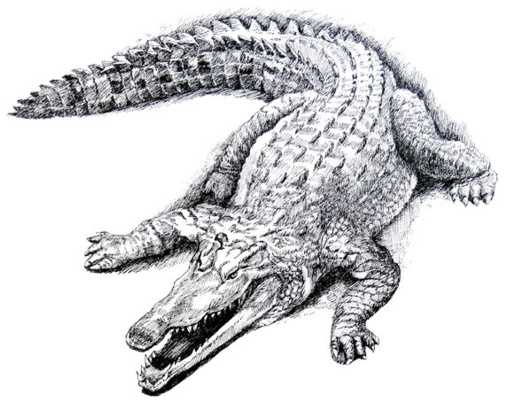
- Refine the shape of the crocodile's paws - they should be massive and clawed. Give them volume and texture.
- Finish the head by adding details to the eyes, nose, ears and mouth. The teeth should look sharp. You can draw folds on the tongue.
- Crocodiles have characteristic ridges on their backs. Add them taking into account the texture of the skin.
- Use shading to create skin texture. Crocodile skin can vary depending on the species - smooth, rough, or even scaly. Add shadows to give volume.
- Use shadows and light to emphasize the shape of the crocodile. Shade the dark areas of the body where there are bends and depressions. Add more shading.
Little kind crocodile
The crocodile in the picture can be depicted using the following master class, which describes the sequence of actions:
- Start by sketching the general outline of the crocodile to get an idea of its shape and proportions.

Draw a small oval, which will be the head. Add another oval - the body. These 2 ovals should be approximately equal in size, but the head should be a little smaller.
- Draw the head, which should appear larger than it actually is due to the close-set eyes.
- The crocodile's body should be slightly elongated and rounded. To give the body volume, draw a few additional lines to create a shadow effect.
- Connect the head and body with a line that will become the curve of the back.
- Draw a tail that starts from the back of the body and curves smoothly downwards. It should be thin and slightly curved. A sharp tip will add playfulness and energy to the crocodile.
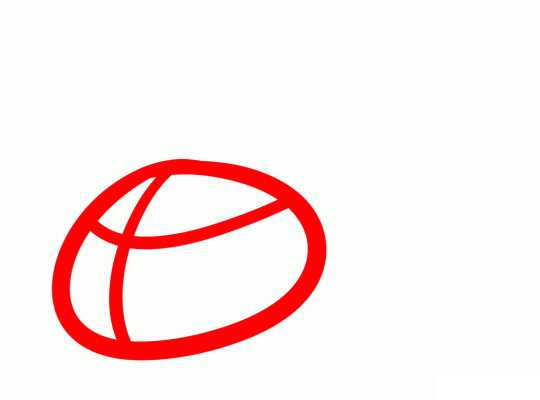
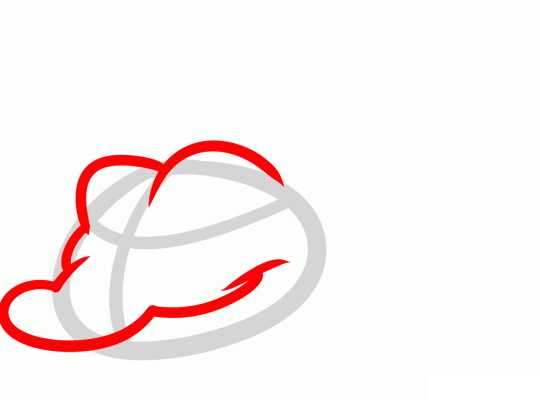
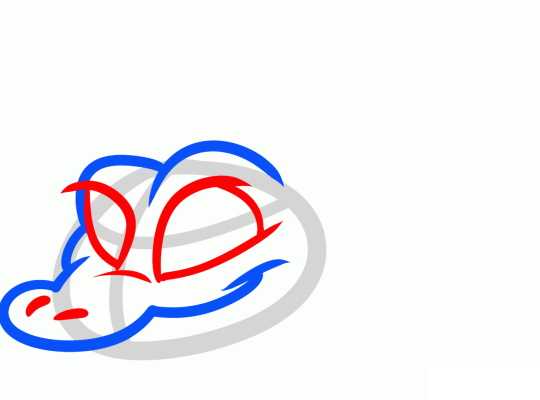
- Sketch the line of the front paw, which comes out of the body at an angle, and draw the back paw, lowered down. The paws should be small and rounded. This will help to maintain the impression that the crocodile is in motion.
- Note that the belly should look slightly convex. To make the crocodile cuter, add a few strokes to indicate the tummy. This can be a small roundness or a fold of skin that gives the tummy volume.
- Draw a large smiling mouth, round eyes and semicircular nostrils. Expressive eyes will help convey the friendly nature of the crocodile.
- The ridges along the back give the crocodiles a recognizable look. Draw several vertical lines running across the back from the neck to the tail. Don't make them too sharp or detailed.
- To create volume, you can add small strokes and lines on the crocodile's skin to show texture and wrinkles.
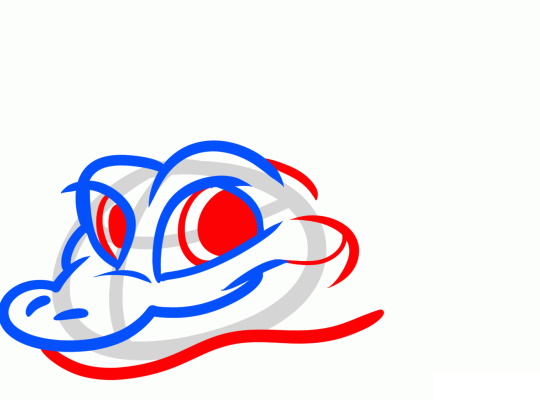
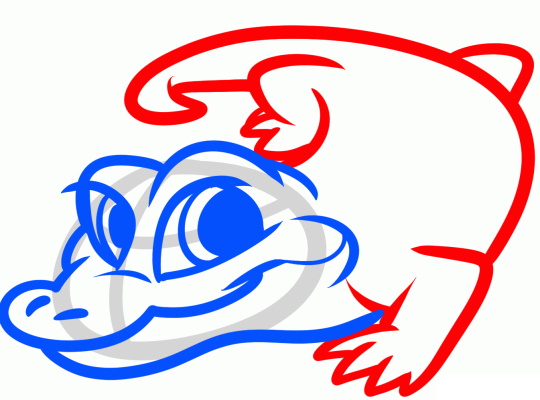
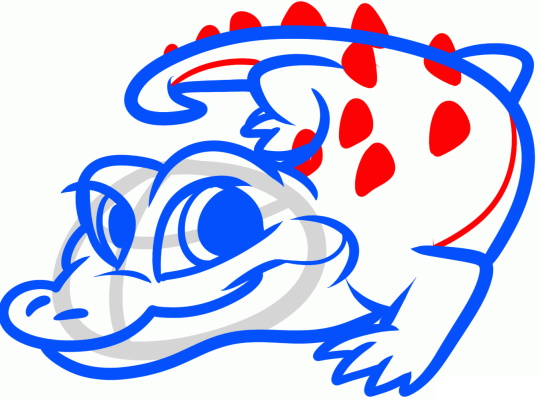
- Choose bright and saturated colors to paint the crocodile.
Gena
Crocodile Gena is one of the most popular characters in Soviet children's literature, created by Eduard Uspensky. In the book "Crocodile Gena and His Friends" he is presented as funny and friendly, working in a zoo.
Despite his outward severity, Gena turns out to be a kind and sympathetic character, ready to help everyone who needs it.
Crocodile Gena, playing the accordion and sitting on a bench, can be drawn using a master class, which covers the main steps:
- Create a general outline of the crocodile's figure, its location on the sheet of paper and the main facial features. Start with the head: draw an elongated oval. The body can be depicted as a rectangle, drawing the paws and tail. Draw lines for the jaw and neck.
- Draw Gena's body and limbs.
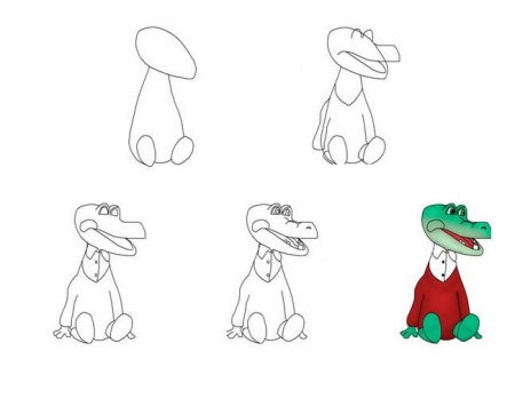
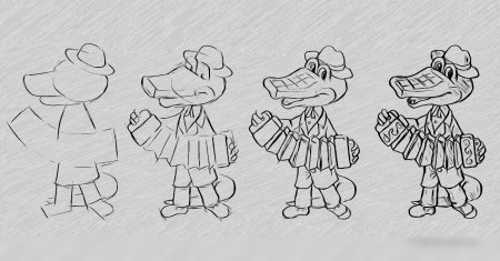
- Draw the crocodile's clothes (for example, a jacket). Mark the folds on the clothes and emphasize the details: buttons, pockets, collar.
- Draw a round nose and eyes, leaving room for a wide smile. Pay special attention to Gena's smile: add teeth using simple curved lines.
- Draw an accordion: indicate its location and shape on the crocodile's knees.
- Improve the background: draw a bench that will help convey the atmosphere of the plot.
- Color the drawing. Choose colors that match the original image of the crocodile Gena: green, brown, yellow, red. Choose light and dark tones to create volume. To add texture, use colored pencils of different hardness.
Mom with a crocodile and eggs
Female crocodiles lay eggs in a nest that they first build from mud and vegetation. The eggs have a strong shell that protects the baby from external influences.
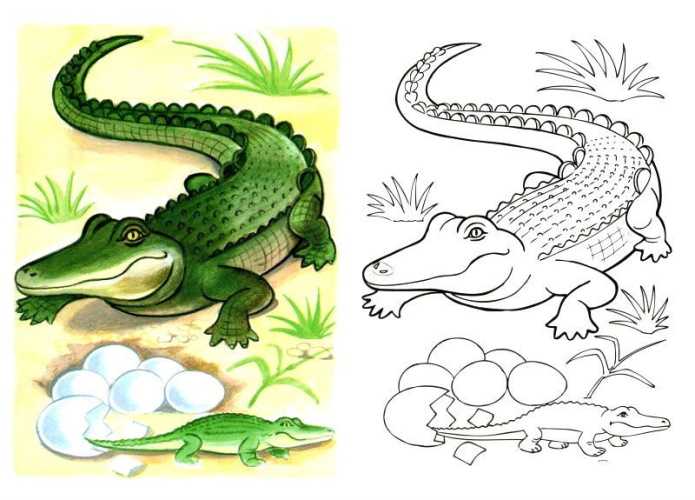
Depending on the type of crocodile, the number of eggs in a clutch can vary from 10 to 100. Newborn crocodiles have all the necessary skills to survive in an aquatic environment.
The crocodile in the picture is depicted using a master class, which is a general recommendation, and the final result depends on the drawing style:
- Draw a small rectangle that will serve as the basis for the female crocodile's body. Sketch out the head in the shape of the letter V, the front and back legs.
This could be the general outline of the crocodile's figure, the place where the eggs will be located, and the approximate size of the future image.
- Draw the head, giving it the shape of an egg. It should be large in comparison to the body, but not too elongated.
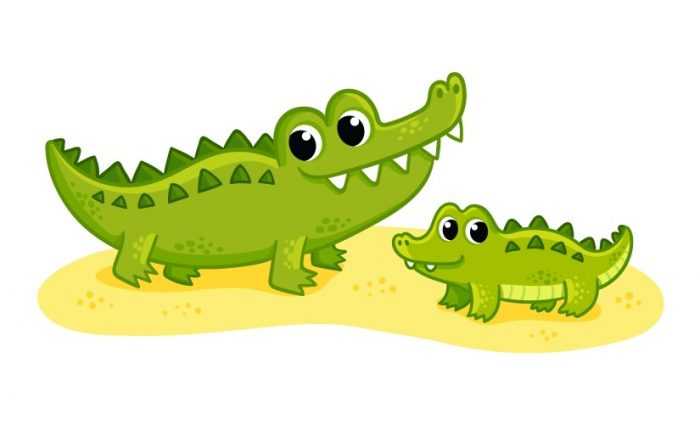
- Add the outline of the body, which should resemble a slightly curved oval. Place it so that it is slightly lower than the head. The body should look muscular. Draw a line from the neck to the tail.
- Make the crocodile's tail pointed and long, curved upwards. Add details to the tip. This will give it a realistic look. The crocodile mother should look strong and dangerous.
- Outline the paws, making them long and powerful. The paw consists of 3 segments, each of which has a bend. The front ones should be bent, the back ones – more straight.
- Draw the crocodile's belly. It should be flat and smooth. The belly does not protrude forward, as it is covered with a thick layer of skin. You can mark slight curves of the skin.
- Draw the crocodile's mouth, making it zigzag and wide.
- Draw the eyes and nostrils, they should be expressive.

- Draw small ridges on the crocodile's head and back. They should not look like spikes, it is best to make them in the form of small lines along the spine.
- To give the skin volume and texture, use shading. On the body it can be denser and more uniform, on the paws - thinner and diagonal. For the head, use smaller and thinner strokes, creating the impression of scales.
- Place several large eggs near the crocodile's body.
- Add 1 broken egg, from which a small crocodile has already crawled out.
- Draw a small crocodile next to the broken egg. Pay attention to the position of the tail and paws, conveying the movement. Draw its head, body and paws, following the same principles as when creating the image of the crocodile.
Pay attention to details to create a lively and expressive image.

- Create a background for the picture by adding sand texture and some grass areas. For the background, use a pencil and strokes to create the sand and grass texture. Use vertical lines for the grass and horizontal lines for the sand.
This way you can add volume and realism to your drawing.
- Use colored pencils to color. Start with the primary colors to create the base tones of the crocodile's skin. Add shadows and shades to create volume and depth.
If necessary, lighter colors can be used to highlight certain details such as the eyes, nostrils, and teeth.
Alligator
Alligators and crocodiles are members of the crocodile order, but belong to different families. Alligators live in North America and China, and crocodiles live in almost all regions with a warm climate.
Externally, an alligator can be distinguished from a crocodile by the shape of the snout. Alligators have a shorter and wider snout, while crocodiles have a narrower and longer snout. Alligators have eyes located closer to the top of their heads, while crocodiles have eyes located closer to the sides of their heads.
Crocodiles are generally larger than alligators, but this depends on the species.
This master class will help you create a beautiful and detailed drawing of an alligator:
- Start by creating a general sketch of the alligator on paper. Use simple lines to outline the outline of its body, head, and tail. This will help determine the basic proportions of the alligator and the overall shape of its figure.
- Draw 2 ovals: 1 smaller one for the head, the other one for the alligator's body. The ovals should be positioned in accordance with the proportions of the animal's body. The head can be made narrower and more pointed than the body.
- Inside the head oval, add the outline of the alligator's snout, including the eyes, nose, and mouth. The snout should be pear-shaped with a slight curve where the neck begins. Pull the lower jaw down to create an aggressive look.
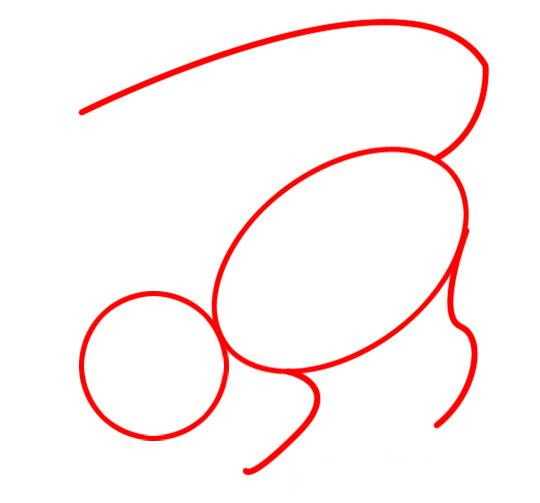
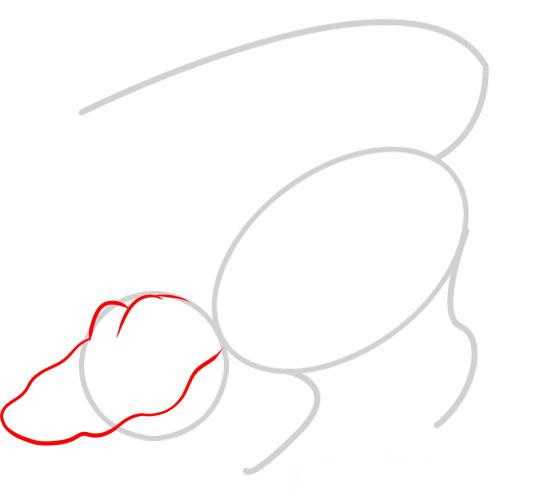

To make the drawing more realistic, it is necessary to take into account some proportions. The eyes should be large and located on the sides of the head, the nose should be between the eyes and have a triangular shape. The mouth can be small and slightly curved, like a reptile.
- Draw the body from an oval. Note that the tail should be longer than the body. Add details on the surface of the oval that will create a sense of volume and skin texture. Emphasize the curve of the spine, especially in the back and abdomen.
- Draw the alligator's tail so that it starts from the bottom of the oval body and is thicker and narrower towards the end. It should bend slightly upwards and end in a sharp tip.
- Draw the alligator's paws. Draw 2 front and 2 back paws. Start with rounded shapes that transition into narrower and longer paws. Draw large claws on the front paws and smaller ones on the back paws. The claws should be sharp and curve downwards.
- Add ridges to the alligator's head and back. They should look like wavy lines running along the length of the body. The ridges add realism to the drawing and make the alligator more expressive.
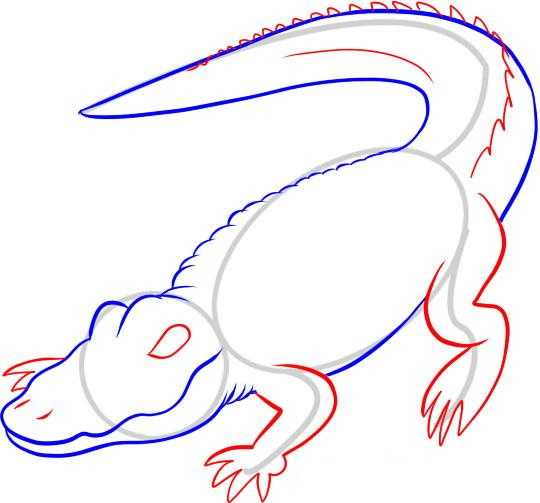


- Make the skin textured by depicting folds and scales. The folds should emphasize the movement of the muscles under the skin, and the scales should look like small uneven dots or strokes. They are drawn unevenly and a little chaotically, creating the effect of roughness of the skin.
Use different shades of grey to create a three-dimensional effect.
- Choose colors for the drawing based on the characteristics of the alligators. The main color can be green or brown, you can add gray and black shades for shadows and details.
Use different techniques to add volume and texture, such as highlights, hatching and shading.
Tips for Beginners
Before you start drawing a crocodile, you need to study the rules and principles of their depiction:
| Basic principles | Brief description |
| Study of the sample | Carefully study the appearance of the crocodile. Pay attention to its shape, size, features of the head, body and tail. This will help create a more realistic drawing. |
| Creating a sketch | Start with a general sketch of the crocodile using light lines. It should be simple and schematic, without details. This will allow you to control the composition and proportions of the drawing. |
| Working out the basic elements | Draw the head, body and tail of the crocodile in more detail. Use smooth and continuous lines to create a natural and organic image. Do not forget about proportions and perspectives. |
| Adding details | Work on details such as eyes, nostrils, teeth and scales. They will help give the crocodile a more lively and expressive look. |
| Shading and toning | Using a pencil, make shadows on the crocodile's body and add light highlights on the eyes and teeth. This will give the drawing volume and depth. |
| Completion | Finish the drawing by emphasizing the outline of the crocodile and adding small details. Make sure the drawing looks harmonious. |
When drawing a crocodile, it is important that children draw it based on observations and ideas. The template will help to study its features. Changes in the sample - to show individuality and express attitude or express the character of a particular character when drawing.
Video about drawing
Crocodile - drawing:
